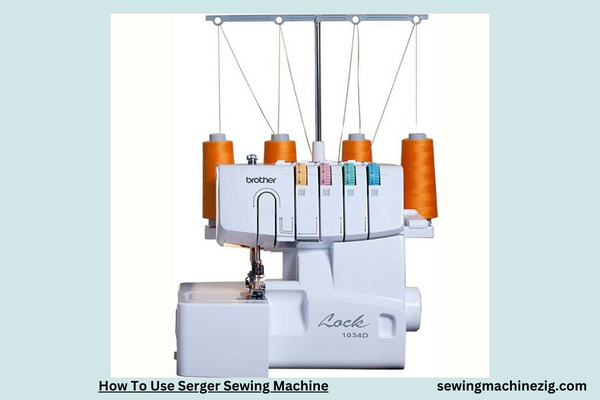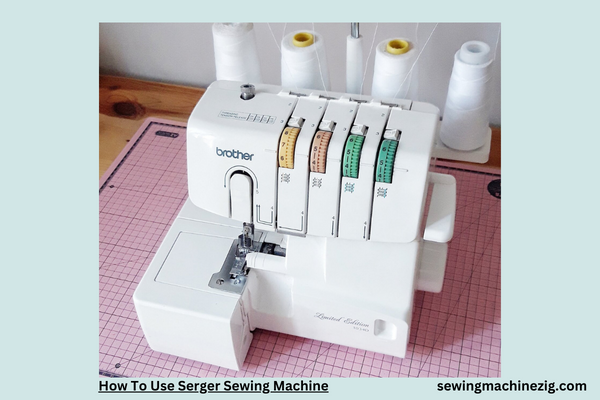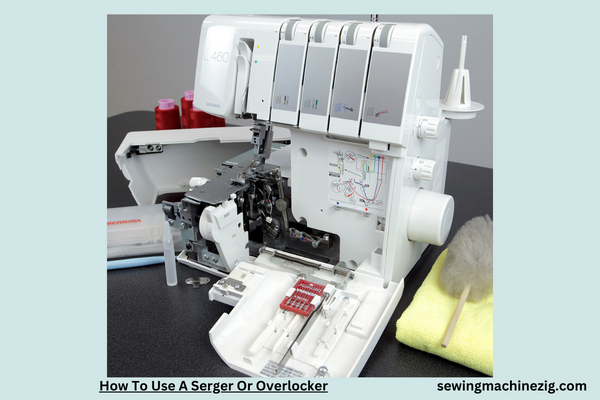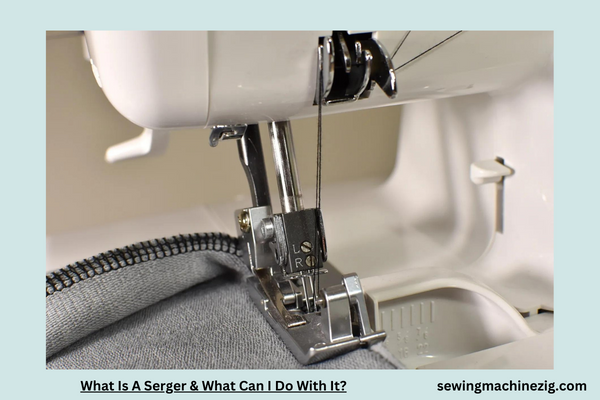
Delving into the realm of sewing craftsmanship is a rewarding journey, and a serger sewing machine is a valuable ally in this creative process. Unveiling the full potential of your serger requires a nuanced understanding of its functionalities. In this comprehensive guide “How To Use Serger Sewing Machine“, we unravel the intricacies of using a serger sewing machine, providing step-by-step insights.
Whether you’re a seasoned enthusiast or just starting, mastering the art of serging opens doors to impeccable finishes and professional-looking seams. Let’s embark on this journey together, exploring the art and finesse of utilizing a serger sewing machine.
How To Use Serger Sewing Machine Detailed Answer

Mastering“How To Use Serger Sewing Machine” the use of a serger sewing machine opens up a world of possibilities for achieving professional finishes and polished seams in your sewing projects. Here’s a detailed step-by-step guide on how to use a serger sewing machine effectively.
Step 1: Familiarize Yourself with the Serger
Before diving into the sewing process, take time to familiarize yourself with the various components of the serger. Identify the loopers, needles, tension dials, cutting blades, and threading paths.
Step 2: Threading the Serger
Threading a serger can seem intricate, but it’s a crucial step. Follow the threading guide provided in your serger’s manual, ensuring each thread is properly guided through the thread guides, tension disks, and threading path.
Step 3: Adjusting Tension Settings
Achieving optimal stitch quality requires proper tension settings. Experiment with the tension dials, adjusting them based on your fabric and project requirements. Practice on scrap fabric to fine-tune the tension settings.
Step 4: Testing Stitches on Scrap Fabric
Before starting on your actual project, test the serger stitches on a scrap piece of fabric. This allows you to evaluate the stitch quality, adjust tensions if needed, and familiarize yourself with the machine’s performance.
Step 5: Understanding Differential Feed
Differential feed is a valuable feature on a serger that helps prevent stretching or puckering of fabrics. Adjust the differential feed setting based on the type of fabric you’re working with to achieve smooth and even stitches.
Step 6: Stitch Selection
Most sergers offer a variety of stitches, including overlock, rolled hem, and flatlock stitches. Choose the appropriate stitch for your project, considering the fabric type and the desired finish.
Step 7: Seaming Fabric Edges
Align the fabric edges and guide them through the serger, keeping a consistent seam allowance. The serger trims excess fabric while simultaneously finishing the raw edges with the selected stitch.
Step 8: Corners and Curves
Navigating corners and curves requires a bit of finesse. Practice easing the fabric through the serger, ensuring a smooth transition without compromising stitch quality.
Step 9: Rolled Hem Feature
Explore the rolled hem feature for creating delicate and professional-looking hems on lightweight fabrics. Adjust the settings and practice on scrap fabric to achieve the desired result.
Step 10: Changing Serger Threads
When switching thread colors or types, follow the threading guide to rethread the serger. Take your time to ensure each thread is correctly placed to avoid tension issues.
Step 11: Finishing and Securing Stitches
At the end of a seam, use the built-in thread cutter to trim the threads. Some sergers also have a chain-off feature that allows you to finish the stitch chain securely.
Step 12: Maintenance and Cleaning
Regularly clean the serger to prevent lint buildup, and follow the manufacturer’s guidelines for oiling specific components. Proper maintenance ensures smooth operation and extends the life of your serger.
Effectively using a serger sewing machine involves a combination of understanding its features, proper threading, experimenting with stitches, and practicing on various fabrics. By following this step-by-step guide, How To Use Serger Sewing Machine you’ll gain confidence in utilizing the serger’s capabilities to achieve professional and polished results in your sewing endeavors.
How To Use A Serger Or Overlocker

Let’s dive into the basics of how to use a serger or overlocker – a versatile sewing companion that adds a professional touch to your projects. Whether you’re a sewing enthusiast or just starting out, understanding the ins and outs of this machine can significantly enhance your crafting experience.
Getting Acquainted:
Begin by familiarizing yourself with the key components of your serger or overlocker. Identify the loopers, needles, cutting blades, and threading paths. Each part plays a crucial role in achieving those neat and tidy seams.
Threading Your Machine:
Threading a serger might seem a bit daunting initially, but most machines have color-coded guides to simplify the process. Follow the numbered sequence or color indications in your manual, making sure each thread is properly guided through the designated paths.
Understanding Tension:
Tension is crucial for achieving balanced stitches. Most sergers have tension dials for each thread. Experiment with these settings on a scrap piece of fabric, adjusting until you achieve the desired stitch quality.
Choosing Your Stitch:
Sergers offer various stitch options, including the standard overlock, rolled hem, and flatlock stitches. Select the stitch that best suits your project. Adjust the settings accordingly, considering factors like fabric type and desired finish.
Seaming Fabric:
Align the fabric edges and guide them through the serger. The machine trims excess fabric while simultaneously finishing the raw edges with your chosen stitch. This simultaneous cutting and stitching process creates professional-looking seams.
Handling Corners and Curves:
When navigating corners or curves, guide the fabric gently through the machine. Lift the presser foot if needed, ensuring a smooth transition without compromising stitch quality.
Utilizing Differential Feed:
Differential feed is a handy feature on a serger that prevents stretching or puckering of fabrics. Adjust the differential feed setting based on the fabric you’re working with, ensuring smooth and even stitches.
Rolled Hem Feature:
Explore the rolled hem feature for creating delicate and professional-looking hems on lightweight fabrics. Adjust the settings, and practice on scrap fabric to achieve the desired result.
Changing Threads:
When switching thread colors or types, follow the threading guide to rethread the serger. Take your time to ensure each thread is correctly placed to avoid tension issues.
Securing and Finishing:
At the end of a seam, some sergers have a chain-off feature to secure the stitches. Alternatively, you can stitch a few extra inches beyond the fabric and then trim the chain manually.
Maintenance:
Regularly clean your serger, change needles as needed, and follow the manufacturer’s guidelines for oiling. Proper maintenance ensures smooth operation and extends the life of your machine. Using a serger or overlocker is a valuable skill that can elevate your sewing projects.
By following these easy steps, How To Use Serger Sewing Machine, you’ll confidently harness the power of your serger to achieve professional-looking finishes and unleash your creativity.
What Is A Serger & What Can I Do With It?

Let’s demystify the serger sewing machine and explore what this nifty tool can do for your sewing projects. If you’ve ever wondered, “What is a serger, and what can I do with it?” you’re in for a treat.
Understanding the Serger:
A serger, also known as an overlocker, is a specialized sewing machine designed to add a professional finish to your creations. Unlike a regular sewing machine, a serger operates with multiple threads, typically between two to eight, creating strong and secure stitches.
Key Components:
A typical serger has loopers, needles, cutting blades, and threading paths. Loopers are responsible for forming the stitches, while needles secure the fabric. The cutting blades trim excess fabric, and threading paths guide the threads through the machine.
Versatile Stitching:
One of the primary functions of a serger is to create overlock stitches, a type of stitch that trims the fabric edge while simultaneously finishing it. This prevents fraying and gives your projects a clean, professional look. Sergers also offer a variety of stitches like rolled hems and flatlocks, expanding your creative possibilities.
Seaming and Finishing:
The serger excels at seaming fabric edges efficiently. Whether you’re working with woven or knit fabrics, a serger produces durable and stretchy seams. Additionally, it can create decorative edges, making it ideal for projects like napkins, tablecloths, and garments.
Differential Feed Feature:
A standout feature of many sergers is the differential feed. This allows you to adjust the speed at which the fabric is fed through the machine, preventing stretching or puckering, particularly useful when working with knits or lightweight fabrics.
Rolled Hem Magic:
Transforming raw edges into elegant, rolled hems is another forte of the serger. With a simple adjustment, you can achieve delicate, professionally finished hems on scarves, lightweight garments, or any project where a subtle edge is desired.
Creating Decorative Effects:
Sergers are not just about functionality; they bring creativity to the table. Experiment with different thread colors and stitch variations to add decorative touches to your projects. This includes creating ruffles, lettuce edges, and unique seam finishes.
Time-Saving Companion:
Beyond its decorative and functional aspects, a serger is a time-saving companion. Its ability to trim, sew, and finish edges in one pass significantly reduces the time spent on sewing projects, making it a valuable tool for sewists with tight schedules.
Tips for Success:
To make the most of your serger, take time to practice threading and adjusting tension. Understanding the features and experimenting with different stitches on scrap fabric will boost your confidence and ensure successful projects.
A serger is a versatile and powerful addition to your sewing arsenal. It’s not just about finishing edges; it’s a creative force that can elevate your projects, giving them a polished and professional appearance. So, dive into the world of sewing and unleash your sewing potential!
Conclusion
In conclusion, delving into How To Use Serger Sewing Machine opens a realm of creative possibilities. By threading the machine, adjusting tension settings, and exploring various stitches, you can achieve professional finishes on your sewing projects.
The serger’s features, such as differential feed and rolled hem options, provide versatility for different fabrics. Mastering the use of a serger enhances your sewing skills, allowing you to create polished seams and delicate hems effortlessly, making your projects stand out with a professional touch.
FAQS
Q1: What is a serger sewing machine, and how is it different from a regular sewing machine?
A1: A serger, also known as an overlocker, is a specialized sewing machine designed for finishing edges. Unlike a regular sewing machine, a serger uses multiple threads to create strong, secure stitches and offers a variety of stitch options. How To Use Serger Sewing Machine
Q2: How do I thread a serger sewing machine?
A2: Threading a serger involves passing threads through loopers, needles, and guides. Follow the numbered threading path, usually indicated on the machine, and refer to your serger’s manual for detailed instructions. How To Use Serger Sewing Machine
Q3: Can I use regular sewing machine thread on my serger?
A3: While you can use regular sewing machine thread, it’s advisable to use thread specifically designed for sergers to ensure optimal performance and prevent potential tension issues.
Q4: What is the differential feed feature on a serger, and how do I use it?
A4: The differential feed adjusts the speed at which the fabric is fed through the machine, preventing stretching or puckering. Experiment with the differential feed settings to achieve smooth and even stitches, especially when working with knits or lightweight fabrics. How To Use Serger Sewing Machine
Q5: How do I change the stitch length and width on my serger sewing machine?
A5: Refer to your serger’s manual for specific instructions on adjusting stitch length and width. Typically, these settings are controlled by knobs or dials on the machine, allowing you to customize stitches according to your project. How To Use Serger Sewing Machine
Q6: Can I create decorative stitches with a serger sewing machine?
A6: Yes, many sergers offer decorative stitch options. Explore your machine’s stitch variations and settings to add creative touches to your projects, such as rolled hems, flatlocks, and decorative edges. How To Use Serger Sewing Machine



